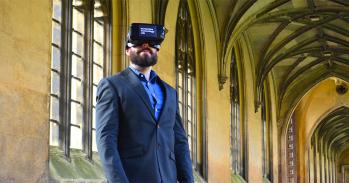
It's space, but is it art? Stunning images of the galaxy are fast becoming common currency thanks to technology like the Hubble Space Telescope, but a unique investigation at the University of Cambridge this week will seek to determine whether something strange is going on behind the scenes.
It's space, but is it art? Stunning images of the galaxy are fast becoming common currency thanks to technology like the Hubble Space Telescope, but a unique investigation at the University of Cambridge this week will seek to determine whether something strange is going on behind the scenes.
By understanding more about how art helps us to conceive the unknown and the unexplored, it's possible we could end up knowing more about how to make people excited about scientific discovery itself.
Barry Phipps
In an event at the University's Institute of Astronomy this Friday (April 9th), researchers from around the world will examine the deft photo-manipulation which usually occurs before images from Outer Space are reproduced in newspapers, magazines or on television, in an effort to understand why it is happening and what it achieves.
Few of the pictures of space that astronomers produce reach the public in their original form. Those sent back by Hubble, for instance, consist of blurred, monochrome, electronic data which is low on both definition and detail.
By the time they hit the front pages, however, they have usually been transformed into colourful and dramatic depictions of planets, nebulae and supernovas.
While most people are under no illusions about the fact that they have been enhanced, many of us are happy to accept them even though we might generally be suspicious about other examples of photographic manipulation.
The one-day symposium, entitled "The Aesthetics of Astrophotography", will try to explore this curious relationship between science, art and the viewing public by shedding light on what is really going on in astronomy's dark room.
"The question we want to ask is why do astronomers employ artistic conventions as part of a scientific project?" organiser Barry Phipps, from Churchill College, Cambridge, said. "What is the relationship between art and what they are trying to do, and why is it useful in communicating their ideas?"
The symposium will bring together representatives from disciplines such as art history, astronomy, photography, science and philosophy, and will focus on how images sent back by Hubble itself are translated and transformed.
The keynote speakers include Elizabeth Kessler, assistant Professor of Art and Liberal studies at Ursinus College in Pennsylvania, whose research has drawn comparisons between images from space and the visual language of Romantic landscape painting in the 19th century.
Just as many of these paintings depicted the awe-inspiring frontier landscapes of places like the American west, Kessler suggests that art gives astronomy its strength by conveying the sense of majesty and wonder experienced by scientists when they glimpse the distant reaches of the so-called final frontier of space.
Phipps added: "We live in an age where art and science have diverged as disciplines, but this is one of the most powerful examples where the two operate together. By understanding more about how art helps us to conceive the unknown and the unexplored, it's possible we could end up knowing more about how to make people excited about scientific discovery itself."
This work is licensed under a Creative Commons Licence. If you use this content on your site please link back to this page.





